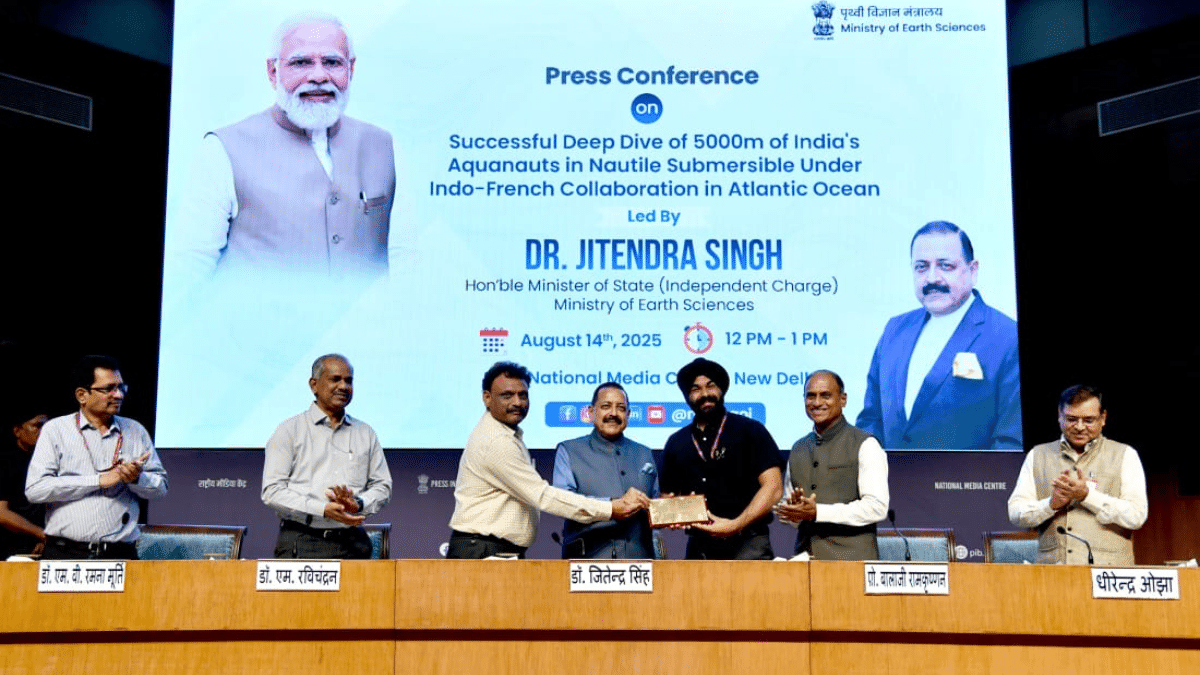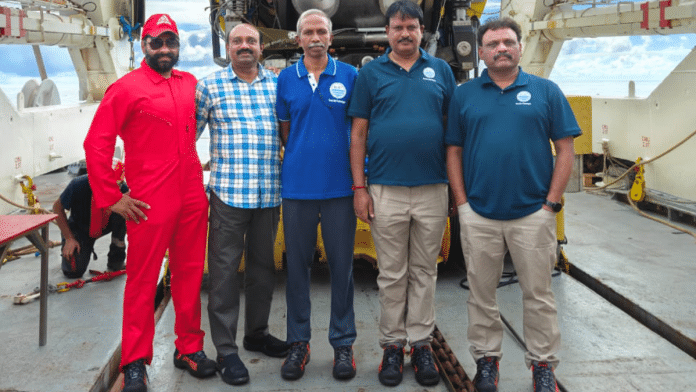New Delhi: Two Indian ‘aquanauts’ from the National Institute of Ocean Technology (NIOT) created history when they went 5,000 metre underwater in a submersible in the Atlantic Ocean on 5 August. Union Minister of Earth Sciences Jitendra Singh announced this feat at a press conference Thursday, and congratulated the NIOT team, which is currently working on India’s own crewed deep sea mission called Samudrayaan.
The mission in the Atlantic Ocean, which was a collaboration between India’s NIOT and France’s IFREMER (or the French Institute for Ocean Science), carried five Indian engineers from the NIOT on board French vessel Nautile on 4-5 August off the coast of Portugal. Two Indian ‘aquanauts’—Raju Ramesh and Jatinder Pal Singh—spent nine hours each underwater in the submersible with two other French aquanauts.
While Ramesh’s dive was up to the depth of 4,000 metre, Singh dived to 5,000 metre and both were the first Indians to reach that depth. The other three Indian aquanauts stayed aboard the ship to help with operations.
“It is only fitting that Shubhanshu Shukla’s space voyage coincided with Ramesh and J.P. Singh’s deep-sea voyage,” Jitendra Singh told the press conference. “Now, as Samudrayaan and Gaganyaan near, we will plan it so that we have an Indian in space and an Indian in the deep ocean at the same time.”
While the Indian Space Research Organisation leads India’s ambitions in space through the Gaganyaan mission, the National Institute of Ocean Technology is steering the Samudrayaan mission beneath the seas—doing in the oceans what ISRO does in space.
Ramesh and J.P. Singh are part of the NIOT team that is building Matsya 6,000, the submersible that will be used in the Samudrayaan mission. With the initial harbour tests done, Samudrayaan is expected to take three aquanauts—including Ramesh and Jatinder Singh—down 6,000 metre into the Indian Ocean. The current collaboration with France was a crucial step in that direction, providing NIOT engineers with valuable experience.

According to NIOT director Balaji Ramakrishnan, the Indo-French collaboration mission was in the works for around two years, but came together at the last minute as the French vessel was ready. Ramesh, Singh, and the three other NIOT engineers flew to Portugal for the mission.
“The mission did not cost us much, only about Rs 1-2 crore which is the cost of using the ship for lowering the submersible,” said M Ravichandran, the secretary of the Ministry of Earth Sciences. “Like most of our missions, this one too was cost-efficient.”
Also Read: Big step for Samudrayaan as ISRO, NIOT complete key weld on deep-sea submersible after ‘700 trials’
Significance of this mission
The pressure 5,000 m underwater is quite strong, and only certain vessels designed to withstand it can undertake the voyage. According to Union Minister Jitendra Singh, India’s aquanauts have joined an elite league of fewer than 30 people in the world who have gone to that depth underwater.
Additionally, before Matsya 6000’s own voyage in 2027, this experience would be useful to the NIOT, which hasn’t undertaken a manned mission underwater yet. While six wet tests were conducted in February this year, there are still some sections like the buoyancy, drop weight system and the titanium hull that are still being worked on for Matsya 6000.
“The aquanauts learned how to maneuver and navigate a submersible 5,000 m underwater, how to check the life support systems, how to use communication systems, and the robotic arm for collecting samples from the seabed,” said M. Ravichandran.
It took close to 2.5 hours for the submersible to travel 5,000 m underwater, and then the aquanauts spent four hours at that depth conducting their research. They tried to take pictures with and without light, tried to use the robotic arm, sent signals to the ship above using acoustic communication systems, and tried to operate the emergency battery systems too.
Now back in India, Ramesh and Jatinder Singh plan to utilise their experience in Samudrayaan’s own journey and building, which is currently ongoing in Chennai. According to Jitendra Singh, this signifies India’s advancement in the blue economy.
“Both Shukla’s flight and Ramesh and Singh’s voyage indicate India is very close to value addition from two sectors – space and deep ocean,” said Singh. “They are going to be the torchbearer of the Viksit Bharat story.”
(Edited by Ajeet Tiwari)
Also Read: India’s first crewed deep-sea mission set for testing—‘We’re to oceans what ISRO is to space’






